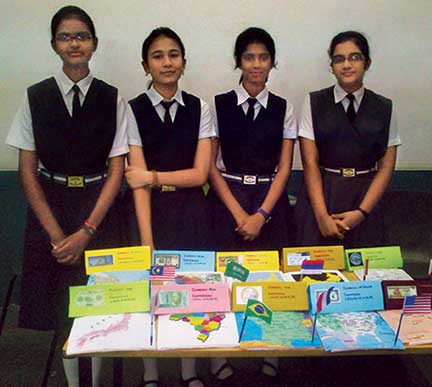 Smita Uchil has been a teacher at K.D. Ambani Vidyamandir for the last 13 years. She loves reading fiction, travelling, dancing, and interacting with others. Smita loves her job because every day she gets to learn new things and grow. A teacher of social science, Smita tackles the challenge of teaching the subject (considered boring by many) by conducting a lot of activities and encouraging children to question. The computer and Internet are her constant aids in building learning materials for her classes.
Smita Uchil has been a teacher at K.D. Ambani Vidyamandir for the last 13 years. She loves reading fiction, travelling, dancing, and interacting with others. Smita loves her job because every day she gets to learn new things and grow. A teacher of social science, Smita tackles the challenge of teaching the subject (considered boring by many) by conducting a lot of activities and encouraging children to question. The computer and Internet are her constant aids in building learning materials for her classes.
History is one of the most interesting and yet difficult subjects to teach. This is because of the popular notion that history is boring and in these modern times absolutely useless. With this kind of attitude history will obviously be a stumbling block for many. As teachers of history it is up to us to make the subject relevant and fun for our students. Here are a few suggestions.
Demonstrate the relevance of history
One of the key challenges that history teachers face is explaining the relevance of history to the present generation. Linking the past to their present will greatly help. For instance, the condition of women in India is an often debated topic. Along with your students look at the treatment meted out to women all those centuries ago. Are there similarities to the way women are treated today? While there may have been a reason for such behaviour in the past, does it justify our behaviour towards women today?
A study of the princely states in India and their ultimate integration will give your students a better insight into the Kashmir problem. Without knowing the past, we cannot understand the present. Why is Gujarat such a prosperous state today? Is their business acumen better than that of people in other states? In this way, linking the past to the present will bring out the importance and relevance of history.
Tell stories
How often have we started history classes telling our students that history is nothing but ‘his’ story – the story of man. So why not tell the story instead of simply reading out in monotonous voices from the textbooks? Today, telling the story of a people from a different era, country, and time is all the more easy with so many books, the Internet, and many television channels to aid us.
Go on field visits
A sure way of grabbing children’s attention is to take them on field visits wherever possible. History is best assimilated on a visit to a historical site. Recently I took my students to Lothal – The Harappan Port Town near Ahmedabad. The children saw the painted pottery, the drainage system, the beads, the statues, the toys of the time, etc. The kids really showed a lot of interest in knowing more about the Harappan civilization. They were spellbound when our guide told us that in their drainage systems, there used to be mechanisms to filter the water before it was let out into the sea. Centuries later we are still struggling to deal with waste water.
If you cannot actually go visit a historical site, go on a virtual tour. These days we have the technology to do that, let us use it.
 Integrate history with other subjects
Integrate history with other subjects
Show your students the links between the different subjects they study and history. How many fiction and non-fiction books have historical backgrounds? A reading of Anne Frank’s diary will help us understand the emotions and turmoil of jews during Hitler’s reign. A Tale of two cities can give us deep insights into the French revolution. And how inter-connected is history with geography? It is the geography of a place that shapes the lives of a people. The Maratha war strategy was a result of the fact that they lived in a predominantly mountainous area. And isn’t there mathematics in history? A study of the architectural style of the Egyptian Pyramids, the concept of symmetry in monuments built, etc., need a mathematical understanding. Scientific discoveries all have a history that led to the discovery, so you can see the connection that science has with history. When you point out these connections, the importance and relevance of history is quite apparent. A study which crosses subject boundaries allows for investigations that can engage children’s imagination. It also gives teachers opportunities to encourage active enquiry, resourcefulness, discussion, and debate by children.
I hope that my fellow teachers find these suggestions helpful in their own classes. Of course these suggestions are not exhaustive and each of you probably has your own successful method, which I would love to hear about. Teaching history requires ingenuity and a realization on our part that we all learn differently, and therefore as teachers the best way to help is not to try to help too much. Let us be facilitators and guides to enhance our students’ learning.
